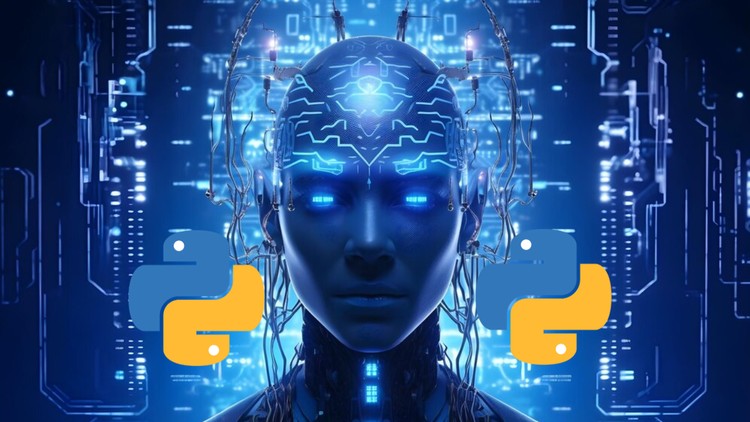Data Science, AI, Machine Learning with Python
- Description
- Curriculum
- FAQ
- Reviews
A warm welcome to the Data Science, Artificial Intelligence, and Machine Learning with Python course by Uplatz.
Data Science
Data Science is an interdisciplinary field focused on extracting knowledge and insights from structured and unstructured data. It involves various techniques from statistics, computer science, and information theory to analyze and interpret complex data.
Key Components:
-
Data Collection: Gathering data from various sources.
-
Data Cleaning: Preparing data for analysis by handling missing values, outliers, etc.
-
Data Exploration: Analyzing data to understand its structure and characteristics.
-
Data Analysis: Applying statistical and machine learning techniques to extract insights.
-
Data Visualization: Presenting data in a visual context to make the analysis results understandable.
Python in Data Science
Python is widely used in Data Science because of its simplicity and the availability of powerful libraries:
-
Pandas: For data manipulation and analysis.
-
NumPy: For numerical computations.
-
Matplotlib and Seaborn: For data visualization.
-
SciPy: For advanced statistical operations.
-
Jupyter Notebooks: For interactive data analysis and sharing code and results.
Artificial Intelligence (AI)
Artificial Intelligence is the broader concept of machines being able to carry out tasks in a way that we would consider “smart.” It includes anything from a computer program playing a game of chess to voice recognition systems like Siri and Alexa.
Key Components:
-
Expert Systems: Computer programs that emulate the decision-making ability of a human expert.
-
Natural Language Processing (NLP): Understanding and generating human language.
-
Robotics: Designing and programming robots to perform tasks.
-
Computer Vision: Interpreting and understanding visual information from the world.
Python in AI
Python is preferred in AI for its ease of use and the extensive support it provides through various libraries:
-
TensorFlow and PyTorch: For deep learning and neural networks.
-
OpenCV: For computer vision tasks.
-
NLTK and spaCy: For natural language processing.
-
Scikit-learn: For general machine learning tasks.
-
Keras: For simplifying the creation of neural networks.
Machine Learning (ML)
Machine Learning is a subset of AI that involves the development of algorithms that allow computers to learn from and make predictions or decisions based on data. It can be divided into supervised learning, unsupervised learning, and reinforcement learning.
Key Components:
-
Supervised Learning: Algorithms are trained on labeled data.
-
Unsupervised Learning: Algorithms find patterns in unlabeled data.
-
Reinforcement Learning: Algorithms learn by interacting with an environment to maximize some notion of cumulative reward.
Python in Machine Learning
Python is highly utilized in ML due to its powerful libraries and community support:
-
Scikit-learn: For implementing basic machine learning algorithms.
-
TensorFlow and PyTorch: For building and training complex neural networks.
-
Keras: For simplifying neural network creation.
-
XGBoost: For gradient boosting framework.
-
LightGBM: For gradient boosting framework optimized for speed and performance.
Python serves as a unifying language across these domains due to:
-
Ease of Learning and Use: Python’s syntax is clear and readable, making it accessible for beginners and efficient for experienced developers.
-
Extensive Libraries and Frameworks: Python has a rich ecosystem of libraries that simplify various tasks in data science, AI, and ML.
-
Community and Support: A large and active community contributes to a wealth of resources, tutorials, and forums for problem-solving.
-
Integration Capabilities: Python can easily integrate with other languages and technologies, making it versatile for various applications.
Artificial Intelligence, Data Science, and Machine Learning with Python – Course Curriculum
1. Overview of Artificial Intelligence, and Python Environment Setup
Essential concepts of Artificial Intelligence, data science, Python with Anaconda environment setup
2. Introduction to Python Programming for AI, DS and ML
Basic concepts of python programming
3. Data Importing
Effective ways of handling various file types and importing techniques
4. Exploratory Data Analysis & Descriptive Statistics
Understanding patterns, summarizing data
5. Probability Theory & Inferential Statistics
Core concepts of mastering statistical thinking and probability theory
6. Data Visualization
Presentation of data using charts, graphs, and interactive visualizations
7. Data Cleaning, Data Manipulation & Pre-processing
Garbage in – Garbage out (Wrangling/Munging): Making the data ready to use in statistical models
8. Predictive Modeling & Machine Learning
Set of algorithms that use data to learn, generalize, and predict
1. Overview of Data Science and Python Environment Setup
-
Overview of Data Science
-
Introduction to Data Science
-
Components of Data Science
-
Verticals influenced by Data Science
-
Data Science Use cases and Business Applications
-
Lifecycle of Data Science Project
-
-
Python Environment Setup
-
Introduction to Anaconda Distribution
-
Installation of Anaconda for Python
-
Anaconda Navigator and Jupyter Notebook
-
Markdown Introduction and Scripting
-
Spyder IDE Introduction and Features
-
2. Introduction to Python Programming
-
Variables, Identifiers, and Operators
-
Variable Types
-
Statements, Assignments, and Expressions
-
Arithmetic Operators and Precedence
-
Relational Operators
-
Logical Operators
-
Membership Operators
-
-
Iterables / Containers
-
Strings
-
Lists
-
Tuples
-
Sets
-
Dictionaries
-
-
Conditionals and Loops
-
if else
-
While Loop
-
For Loop
-
Continue, Break and Pass
-
Nested Loops
-
List comprehensions
-
-
Functions
-
Built-in Functions
-
User-defined function
-
Namespaces and Scope
-
Recursive Functions
-
Nested function
-
Default and flexible arguments
-
Lambda function
-
Anonymous function
-
3. Data Importing
-
Flat-files data
-
Excel data
-
Databases (MySQL, SQLite…etc)
-
Statistical software data (SAS, SPSS, Stata…etc)
-
web-based data (HTML, XML, JSON…etc)
-
Cloud hosted data (Google Sheets)
-
social media networks (Facebook Twitter Google sheets APIs)
4. Data Cleaning, Data Manipulation & Pre-processing
-
Handling errors, missing values, and outliers
-
Irrelevant and inconsistent data
-
Reshape data (adding, filtering, and merging)
-
Rename columns and data type conversion
-
Feature selection and feature scaling
-
useful Python packages
-
Numpy
-
Pandas
-
Scipy
-
5. Exploratory Data Analysis & Descriptive Statistics
-
Types of Variables & Scales of Measurement
-
Qualitative/Categorical
-
Nominal
-
Ordinal
-
-
Quantitative/Numerical
-
Discrete
-
Continuous
-
Interval
-
Ratio
-
-
Measures of Central Tendency
-
Mean, median, mode,
-
-
Measures of Variability & Shape
-
Standard deviation, variance, and Range, IQR
-
Skewness & Kurtosis
-
-
Univariate data analysis
-
Bivariate data analysis
-
Multivariate Data analysis
-
6. Probability Theory & Inferential Statistics
-
Probability & Probability Distributions
-
Introduction to probability
-
Relative Frequency and Cumulative Frequency
-
Frequencies of cross-tabulation or Contingency Tables
-
Probabilities of 2 or more Events
-
Conditional Probability
-
Independent and Dependent Events
-
Mutually Exclusive Events
-
Bayes’ Theorem
-
-
binomial distribution
-
uniform distribution
-
chi-squared distribution
-
F distribution
-
Poisson distribution
-
Student’s t distribution
-
normal distribution
-
-
Sampling, Parameter Estimation & Statistical Tests
-
Sampling Distribution
-
Central Limit Theorem
-
Confidence Interval
-
Hypothesis Testing
-
z-test, t-test, chi-squared test, ANOVA
-
Z scores & P-Values
-
Correlation & Covariance
-
7. Data Visualization
-
Plotting Charts and Graphics
-
Scatterplots
-
Bar Plots / Stacked bar chart
-
Pie Charts
-
Box Plots
-
Histograms
-
Line Graphs
-
ggplot2, lattice packages
-
-
Matplotlib & Seaborn packages
-
Interactive Data Visualization
-
Plot ly
-
8. Statistical Modeling & Machine Learning
-
Regression
-
Simple Linear Regression
-
Multiple Linear Regression
-
Polynomial regression
-
-
Classification
-
Logistic Regression
-
K-Nearest Neighbors (KNN)
-
Support Vector Machines
-
Decision Trees, Random Forest
-
Naive Bayes Classifier
-
-
Clustering
-
K-Means Clustering
-
Hierarchical clustering
-
DBSCAN clustering
-
-
Association Rule Mining
-
Apriori
-
Market Basket Analysis
-
-
Dimensionality Reduction
-
Principal Component Analysis (PCA)
-
Linear Discriminant Analysis (LDA)
-
-
Ensemble Methods
-
Bagging
-
Boosting
-
9. End to End Capstone Project
-
3Part 1 - Variables, Data Types, Data Structures, Methods in PythonVideo lesson
-
4Part 2 - Variables, Data Types, Data Structures, Methods in PythonVideo lesson
-
5Part 3 - Variables, Data Types, Data Structures, Methods in PythonVideo lesson
-
6Part 4 - Variables, Data Types, Data Structures, Methods in PythonVideo lesson
-
28Part 1 - Data Cleaning & Pre-Processing for Data Science and Machine LearningVideo lesson
-
29Part 2 - Data Cleaning & Pre-Processing for Data Science and Machine LearningVideo lesson
-
30Part 3 - Data Cleaning & Pre-Processing for Data Science and Machine LearningVideo lesson
-
31Part 4 - Data Cleaning & Pre-Processing for Data Science and Machine LearningVideo lesson
-
32Part 5 - Data Cleaning & Pre-Processing for Data Science and Machine LearningVideo lesson
-
33Part 1 - Data Visualizations in Python - Matplotlib and SeabornVideo lesson
-
34Part 2 - Data Visualizations in Python - Matplotlib and SeabornVideo lesson
-
35Part 3 - Data Visualizations in Python - Matplotlib and SeabornVideo lesson
-
36Part 4 - Data Visualizations in Python - Matplotlib and SeabornVideo lesson
-
43ML - Supervised RegressionVideo lesson
-
44ML - Supervised ClassificationVideo lesson
-
45Part 1 - ML - Unsupervised ClusteringVideo lesson
-
46Part 2 - ML - Unsupervised ClusteringVideo lesson
-
47Part 1 - ML - Unsupervised Association Rule MiningVideo lesson
-
48Part 2 - ML - Unsupervised Association Rule MiningVideo lesson
-
50Case Studies - Data Cleaning & Preprocessing - Melbourne HousingVideo lesson
-
51Part 1 - Case Studies - Data Analysis on NetflixVideo lesson
-
52Part 2 - Case Studies - Data Analysis on NetflixVideo lesson
-
53Part 1 - Case Studies - DC & EDA - Heart Failure AnalysisVideo lesson
-
54Part 2 - Case Studies - DC & EDA - Heart Failure AnalysisVideo lesson

External Links May Contain Affiliate Links read more





